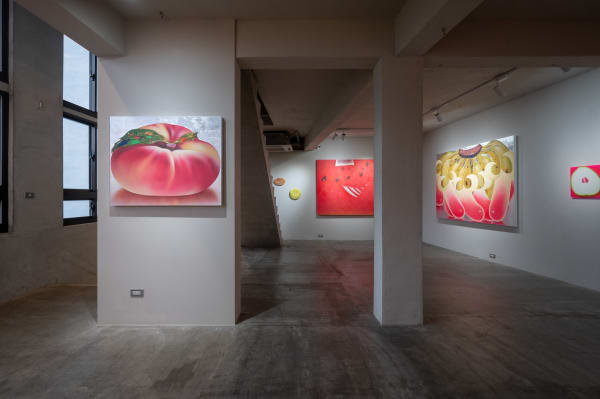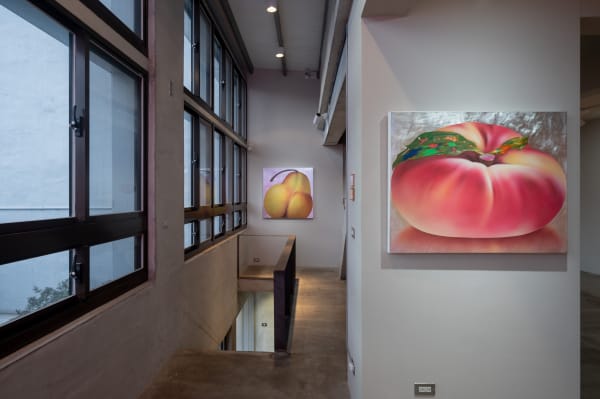Huang Wang-Fu: Go To Southland
Text/ Huang Wang-Fu
The golden maple tree in front of my childhood home, the long, calm streams, the distant mountains shrouded in morning mist, and the stunning landscapes of the southern region-these images are etched in my memory. Born in the South but having lived and worked in the North for eight years, I find myself constantly longing for the life back in the South.
Over time, this longing has evolved into a form of desire. Speaking of "desire," it's deeply intertwined with human social life. Desire stems from our biological nature-a drive to achieve certain goals. Human desires are complex, encompassing survival, enjoyment, and growth. These needs form a multifaceted structure that shifts with changes in societal environments and historical conditions.
In my Fruit Series, I use an anthropomorphic approach to representation. These fruits appear irresistibly sweet and luscious, evolving either naturally or through human intervention to satisfy human desires and needs. I chose fruit as my subject to personify and materialize desire. For instance, one of my paintings features a green apple with a deliberate bite mark. Before painting, I prepare the base layer, and once finished, I use a carving knife to expose the base color at the bite mark. This technique adds rhythm and depth to the composition, turning the painting into exactly what I envisioned-a realization of desire.
Most of the fruits I paint have distinctive expressions, though not always. The decision depends on the composition and texture I aim to achieve. For example, when painting a watermelon, I might emphasize its ripeness by showing cracks that resemble a smile. I intentionally arrange the seeds in a way that forms a facial expression. These choices in composition and rhythm bring a sense of playfulness and liveliness to the work.
In my creative process, I focus on the essence of painting itself, tackling fundamental challenges of the medium. My style, if categorized simply, would fall under figurative painting. One common issue with figurative painting is how to handle the background-it's often harder to paint than the main subject despite appearing simpler. Each subject demands a unique background. For example, in my recent banana paintings, I applied silver leaf to create a stark contrast with the fruit. However, this contrast presented a challenge: the textures felt disconnected. Traditionally, one might solve this by adding a shadow to ground the subject. After much thought, I decided to add a reflection instead. This immediately harmonized the relationship between the subject and the background, making the entire piece feel brighter and more cohesive.
The banana's tip is painted in a bright pink, not only to enhance the composition but also as part of its anthropomorphic quality. Anthropomorphism doesn't always have to involve expressions-it can be conveyed through color. The pink, for instance, reminds me of the flushed faces of cartoon characters when they're angry or shy. This playful shade adds a hint of ambiguity and allure, making the banana simultaneously a cohesive whole and a restless individual.
_
Enchanting Feast, Plastic Love: A Reflection on Huang Wang-Fu's Go To Southland
By Sid Chen
I slowly devour this honeyed
Rosy corpse. Such a red-
Like the blood coursing through a syringe,
As red as the desire fading
From her cheeks-this enchanting feast.
-Ma Yan, "Cherry" (2004)
In his first solo exhibition in Taipei, Go To Southland, Beijing-based artist Huang Wang-Fu presents his recent, strikingly iconic series of fruit paintings. These glossy, vividly artificial fruits, rendered in acrylic paint, aim to stir more than just the viewer's appetite.
Huang's works, showcased in this exhibition, stand out for their playful visual language, sensual use of color, and their bold, hybridized materiality. These distinctive features reveal the artist's unique take on painting. Set against silver foil backdrops, the fruits-painted in vibrant acrylic hues-appear as if wrapped in the gloss of an Instagram filter, exuding a youthful sheen. The rough imperfections typically found in overripe or decayed fruit are nowhere to be seen.
Peel back the sepals clinging to the tip of a banana, and what emerges is an alluring feast-a Plastic Love. Huang skillfully exploits the characteristics of acrylic paint, using diverse techniques to break free from conventional still-life representation. By slicing open the structure of fruit, each layer of pigment and color evokes different sensory perceptions, offering the viewer a rich, multi-dimensional visual experience. This ambiguous interplay between material, image, texture, and form is central to Huang's practice.
The reflective quality of the silver foil backgrounds further deepens this ambiguity. Huang often paints faint reflections and shadows beneath the fruits, making them appear as though they are physically placed against the backdrop. This technique cleverly subverts realism, inviting viewers to consider the layered meanings within these vivid, artificial tableaux.
Throughout art history, many painters and writers, like Huang, have explored desire through the biological forms and imagery of fruits and vegetables. Perhaps the fruits in Huang's paintings are borrowed from Caravaggio's Basket of Fruit, modernized through a kind of plasticized cosmetic surgery that suspends them in the fleeting moments before youth fades. Unlike most artists, however, Huang toys with diverse visual languages within a single painting, amplifying the provocative and imaginative qualities of his still-life compositions. He deeply understands how colors can ignite our senses and how human associations and projections blur the boundaries of desire.
These seductive, ambiguous feasts require no explicit explanation from the artist. What you see is what you consume.
























